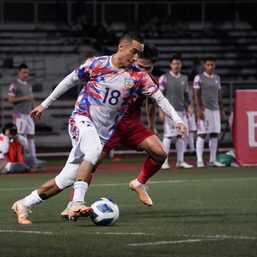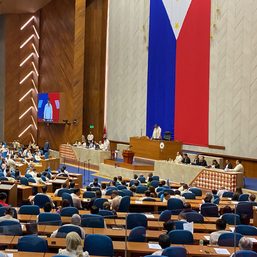SUMMARY
This is AI generated summarization, which may have errors. For context, always refer to the full article.

If there ever was an underdog sports story in 2023 that captured the imagination and adoration of a nation, it was that of the Philippine women’s football team.
The love affair between the squad and the Filipino fans, though, was a slow burn. It took years to generate interest from a local sports fandom whose default favorite had always been basketball. Football, or women’s football for that matter, never quite established an affinity with Filipino sports fans who, aside from basketball, preferred women’s volleyball, boxing, and billiards over the world’s most popular sport.
Even after the Filipinas defeated Chinese Taipei on penalties in the 2022 AFC Women’s Asian Cup in India to become the first team from the Philippines, women or men, to qualify for the FIFA World Cup, Filipino fans did not gravitate instantly toward the squad. The Filipinas’ support base remained confined mostly to fans of the beautiful game and loyal followers who have stuck it out with the team from the time they were still known as the Malditas.
In fact, when the country hosted the 2022 AFF Women’s Championship, the Filipinas beat the Australian Under-23 squad in a 1-0 win at the Rizal Memorial Stadium, which drew less than a thousand spectators. Former head coach Alen Stajcic had to implore the fans to come out and watch the games, saying that the Filipinas deserved a packed stadium.
And come out the fans did. From a crowd of over 3,000 who watched the Philippines demolish five-time champion Vietnam, 4-0, in the semifinals, the attendance grew to 8,000 plus fans in the championship match, where the Filipinas dominated defending champion Thailand, 3-0.
It took a while, but Filipino fans finally came around.
This mirrors the journey of the Filipinas in 2023. Unlike in 2022, which was highlighted by three historic achievements – qualifying for the FIFA World Cup, copping a bronze medal in the SEA Games, and winning the AFF Women’s Championship for the country’s first title in a major international football tournament – the Filipinas’ 2023 season was more subdued but characterized by a steady growth and a gradual ascent to international relevance.
To reduce its season to a mere win-loss record would not be reflective of the successful run the squad put on this year. The Philippines was one of the busiest national teams in 2023, seeing action in six tournaments and playing a total of 21 matches, including two friendlies.
The team wound up with 10 wins and 11 setbacks. The step up in the level of competition had the Filipinas play in the Pinatar Cup in Spain against European squads, the first round of the AFC Olympic qualifier in Tajikistan, the Women’s World Cup in July, the Asian Games in China, and the second round of the AFC Women’s Olympic Qualifying Tournament in Australia. The only regional event the squad joined was the SEA Games in Cambodia. Aside from the World Cup, it was the first time that the Philippines was represented in the Pinatar Cup and the Asian Games.
Out of the 11 losses the Filipinas suffered, three came against countries ranked in the world top 10 – No. 1 Sweden, No. 3 USA, and No. 8 Japan. The other seven losses came against countries in the top 30, among them world No. 11 Australia, No. 13 Norway, No. 14 Iceland, and No. 20 South Korea. Their only surprise loss came against world No. 51 Myanmar, 1-0, in the SEA Games. The Filipinas, though, exacted revenge by thumping Myanmar in the Asian Games, 3-0.
The Filipinas earned impressive wins over three countries that outranked them in the FIFA standings. They downed regional rival and world No. 34 Vietnam, 2-1, in the SEA Games and repeated over world No. 38 Chinese Taipei in the Olympic qualifier, 4-1.
But the most significant win of the Filipinas, without a doubt, happened in the World Cup. Its backs against the wall in a must-win match against a New Zealand home side being cheered on by a hostile, capacity crowd of 32,357, the Filipinas showed courage and heart that not even the most cynical Filipino fan could continue to invalidate and ignore.
The Filipinas repelled wave after wave of attack by the Football Ferns of New Zealand, who were riding the momentum of their stunning triumph over Norway on opening day. The Filipinas’ stonewall resilience eventually bore fruit at the 24th minute. A crease in New Zealand’s defense enabled Sara Eggesvik to chip the ball to the box before it was met midair by a courageous header from Sarina Bolden, who outjumped three defenders. When the ball found the back of the net, Filipino fans at the Wellington Regional Stadium erupted in pandemonium, their loud cheers drowning the anguished groan of Kiwi fans in attendance.
Bolden’s goal sent shockwaves around the entire football community. No one who was not a Filipino believed the Philippines could pull off a win in its maiden World Cup appearance. Foreign media predicted the Filipinas would finish the tournament with three losses, all of them via blowout. This grim prognostication was not without basis. The Philippines, after all, was an unknown entity in the global stage. This was the World Cup, the pinnacle of football. If making it to the main draw was already too difficult, imagine the depths of the struggle just to notch a win at this level of competition. It took New Zealand six editions of the World Cup before it finally scored its first-ever victory.
There was a sprinkling of watch parties in some parts of Metro Manila that allowed Filipinos the chance to witness the biggest win in Philippine football history. By the time the Filipinas suited up for their third and final match against Norway, the watch parties had multiplied many times over in different parts of the country, enabling football and non-football fans alike to congregate and cheer for the national team.
The scene in Auckland was even more surreal. Filipinos from all over the world marched to the beat of drums toward the stadium and filled up Eden Park to the rafters. FIFA recorded 34,697 fans in the venue. The estimate was that around 90% of the crowd rooted for the Philippines. Norway coach Hege Riise said, “It felt like we were an away team playing a home team.”
Filipino fans have always loved winners, The likes of Hidilyn Diaz, Carlos Yulo, EJ Obiena, Eumir Marcial, Nesthy Petecio, Carlo Paalam, Chezka Centeno, Alex Eala, and Margielyn Didal have all gained national prominence due to their various conquests in the international stage. All of them are great athletes who excelled in individual events.
It is worth noting, though, that in team sports, no national team other than Gilas Pilipinas has gained the kind of adulation that the Filipinas experienced from fans in 2023.
Surely, it did not just materialize during the World Cup. Maybe all their exploits this year, whether they won or lost, put them in the spotlight long enough for Filipino fans to take notice and become enamored with the team. But it is hard to put a finger on what exactly established that connection between the team and Filipino fans, who have never been the easiest to please.
Perhaps it was Hali Long, the anchor of the Filipinas defense, shedding tears whenever the national anthem was played. Or Bolden being golden with her prolific goal scoring. Or maybe fans were mesmerized by the marvelous saves of Olivia McDaniel. It could have been Eggesvik and Jaclyn Sawicki holding the fort at midfield as Angie Beard and Jessika Coward pushed back world-class strikers. Or Katrina Guillou and Quinley Quezada attacking relentlessly despite being hounded by bigger and heftier defenders.
The Filipinas have already moved up in the FIFA world rankings. At 38th in the world, the highest-ever standing achieved by a Philippine football team, the Filipinas are now the second-highest ranked Southeast Asian team behind No. 37 Vietnam. The Philippines is currently sixth among all Asian teams. Just two years ago, the Philippines ended the year ranked 64th in the world.
The recent announcement that current head coach Mark Torcaso resigned from his club in the Australian Women’s A-League, the Western United, so that he could work full-time for the Philippine team bodes well for the Filipinas. Torcaso, 2022 Australian Women’s A-League Coach of the Year, is a top-notch tactician who is more than capable of leading the Filipinas to an even higher plane in the international scene.
The challenge moving forward for the Filipinas would be not only to sustain the gains of the past two years but also to further heighten the level of interest of fans. 2023 was a great year for the Filipinas; 2024 should even be better. – Rappler.com
Add a comment
How does this make you feel?















There are no comments yet. Add your comment to start the conversation.